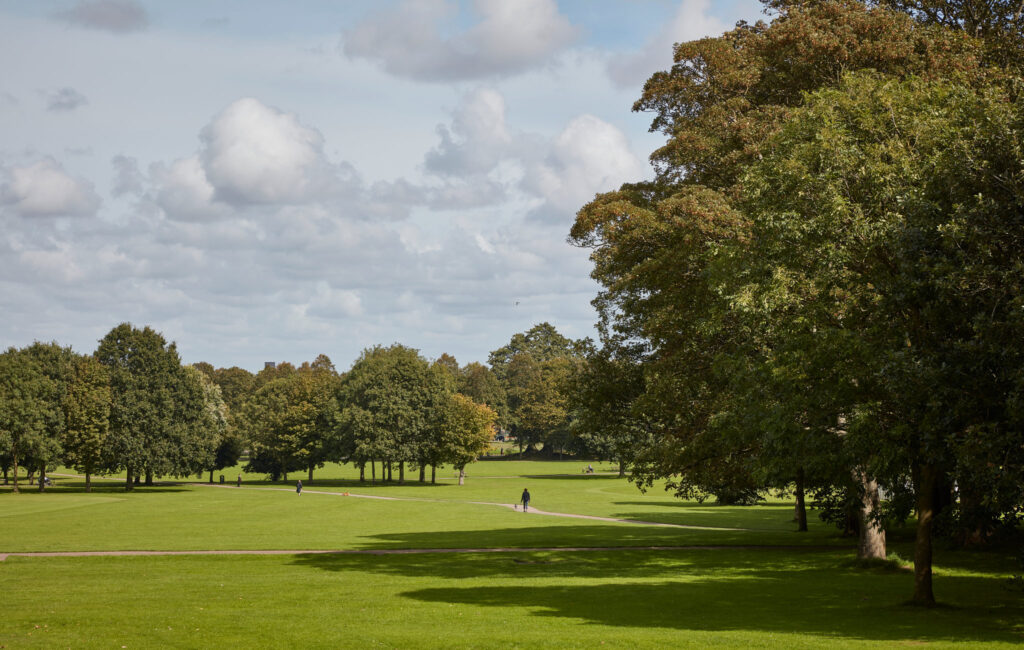LISTEN TO THIS ARTICLE:
Research shows that spending time in nature, either in green spaces or blue (aquatic) spaces, can improve one’s mental health. Given that many of us spend as much as 10 hours daily interacting with screens, green and blue spaces are a much-needed break. “Exposure to nature has been linked to a host of benefits, including improved attention, lower stress, better mood, reduced risk of psychiatric disorders and even upticks in empathy and cooperation.”8
As well, “feeling connected” to nature, “regardless of how much time one spends outdoor”, can produce positive mental health results.8 Nature connectedness, where one links nature to their identity, has shown results that find better cognition, more happiness, and less isolation.
Supporting research
How does it work? Well, scientists at Stanford University studied two groups, one group who walked for 90 mins in nature and one group who walked for 90 mins along a highway. They measured both groups by taking brain scans before and after. They discovered significant changes in brain activity patterns. “Neural activity in the prefrontal cortex, a brain region active during ruminations – repetitive thought focused on negative emotions – decreased among participants who walked in nature versus those who walked in an urban environment.”3
Exercise in green spaces decreases negative thought patterns for people.
Researchers are also discovering that natural spaces in urban environments can produce similar mental health results. Researchers in the UK “found people who had spent at least two recreational hours in nature during the previous week reported significantly greater health and well-being.”8 However, given that so many people live in urban areas, green and blue spaces may be hard to come by. “Our planet is currently experiencing the largest wave of urban growth in history, with 55% of the world’s population (4.2 billion people) currently living in urban areas, a figure set to rise to 70% by 2050.”7

Urban green spaces
The good news is that urban parks and trees work well too. They give people the opportunity for “the mental fatigue of modern life to be countered by psychological restoration.”4 Urban green space includes “parks, sports fields, community gardens, cemeteries, natural meadows, protected areas woodlands and shrublands.”1

Researchers at University College in Dublin found that experiencing green spaces improves psychological health in the following ways:
- Decreasing stress hormone (cortisol) levels
- Buffering negative effects of stressful life events
- Decreasing depression
- Increasing social connection
- Increasing a sense of well-being
- Increasing social support and sense of community
Additionally, the National Alliance on Mental Health states that being in nature can “improve sleep and reduce stress, increase happiness and reduce negative emotions, promote social interactions and even help generate a sense of meaning to life.”9
People who spend more time in nature are less likely to experience symptoms of anxiety and depression.
Lincoln Larson and Aaron Hipp, Associate Professors of Parks, Recreation, and Tourism Management at North Carolina State University also discuss the positive outcomes from spending time in nature. They found that even a trip to a farmer’s market can produce physical and mental benefits. Physically, time in nature can also “foster healthy eating”2, an important factor for those living with mental health conditions. They found that people who spend more time in nature “are also less likely to display anxiety disorders and depression and more likely to report high levels of happiness and well-being.”2 They also state that being in green and blue spaces has economic benefits as time in nature has been linked to less spending on health care and “higher levels of financial well-being and security.”2
Exercise in nature
Exercise can also help depression and anxiety. According to the Mayo Clinic, regular exercise may help symptoms of depression and anxiety by:
- Releasing feel-good endorphins
- Taking your mind off worries
- Gaining confidence
- Getting more social interaction
- Coping in a healthy way
Getting out into nature and exercising can seem like a daunting task when one is experiencing symptoms of mental illness, but the good news is that even small steps can produce results. Women’s Running, an online magazine, suggests starting small.
- Go for a short walk
- Commit to 5 minutes rather than trying to tackle a longer workout
- Think outside the gym
- Schedule exercise into your daily plans
- Find an exercise buddy
Combining exercise and time spent in green and blue spaces can help ease mental health symptoms and build new coping mechanisms. Though, if exercising seems too intimidating, sitting outside and being in a natural environment will provide benefits. Our relationship with and our appreciation of nature is critical in supporting good mental health.

 Learn
Learn Read Stories
Read Stories Get News
Get News Find Help
Find Help
 Share
Share
 Share
Share
 Share
Share
 Share
Share



